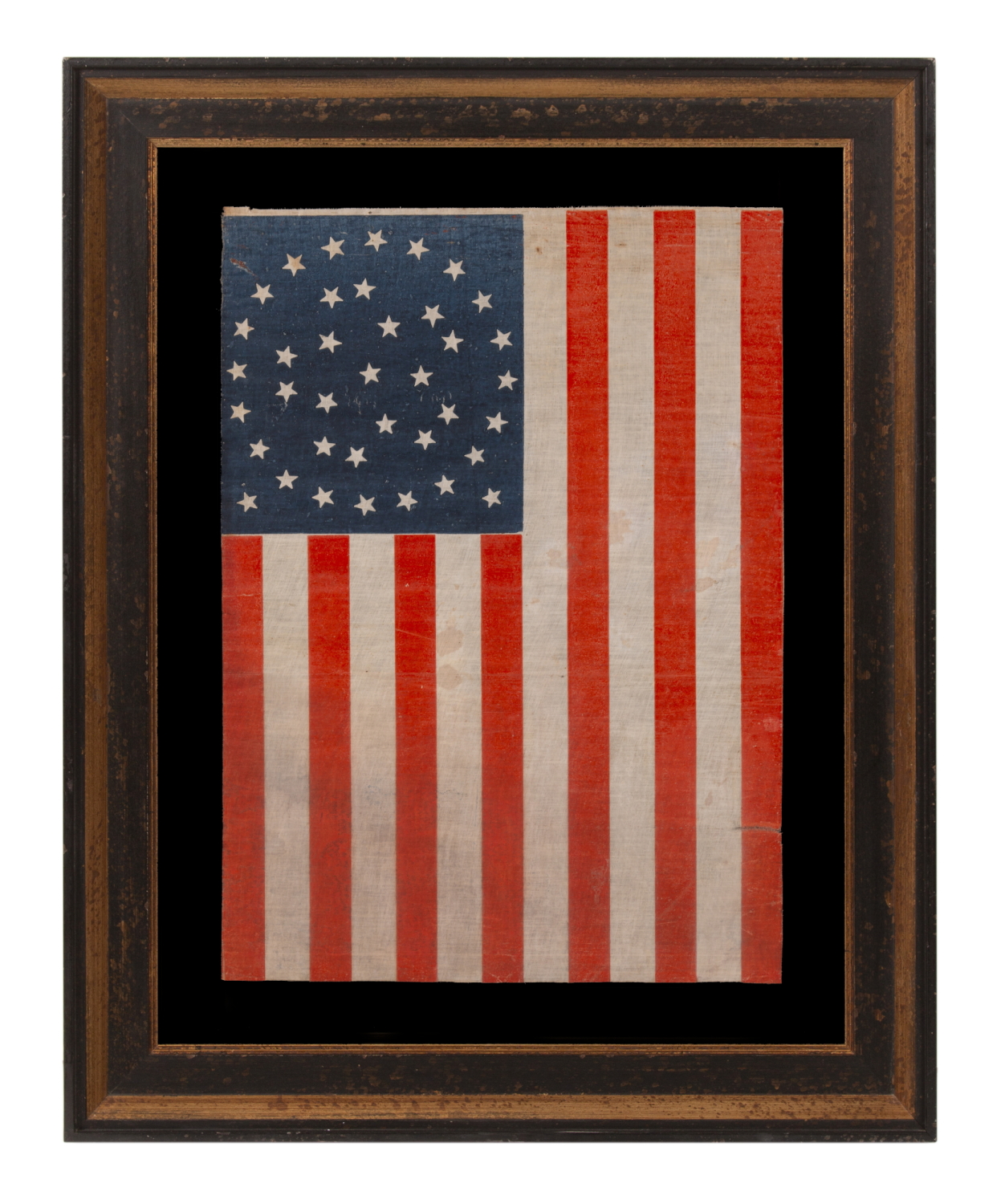


| 38 STARS IN AN EXCEPTIONALLY RARE “GREAT-STAR-IN-A-WREATH” CONFIGURATION, 1876-1889, REFLECTS THE ADMISSION OF COLORADO AS THE CENTENNIAL STATE |
|
| Web ID: | 38j-945 |
| Available: | In Stock |
| Frame Size (H x L): | 38.5" x 30.75" |
| Flag Size (H x L): | 27.75" x 19.75" |
| Description: | |
| 38 star American national parade flag, printed on coarse, glazed cotton, in one of the more beautiful and interesting medallion style configurations that exists across early examples. This consists of a wreath of stars, inside which a “Great Star” pattern (a large star made out of smaller ones stars) is embedded. Though the design can be difficult to interpret at first glance, note how the outermost points of the 5 arms of the Great Star reach into and from part of the circular ring, hence its categorization: “Great Star-in-a-Wreath.” Where there are usually four flanking stars in a medallion type pattern, placed one in each corner of the blue canton, not here that there are only two. This off-balance condition was intentional, leaving room for the easy addition of two more states. Flag-makers of the late 19th century knew that more Western Territories were soon to be added, eagerly anticipating their arrival as a means to produce and sell new flags. The same, as-of-yet unidentified company that produced this particular flag was also likely the maker of a similar variant that I have owned, in a similar size. Printed on the same sort of fabric, in similar pigments, it would be easy to mistake the Great Star-in-a-Wreath style for the other, which displays a more common triple wreath of concentric rings. Colorado entered the Union as the 38th state on August 1st, 1876. This was the year of our nation’s 100-year anniversary of independence. Per the Third Flag Act of 1818, stars were not officially added until the 4th of July following a state's addition. For this reason, 37 was the official star count for the American flag in 1876. Flag-making was a competitive venture, however, and few flag-makers would have been continuing to produce 37 star flags, when their competitors were making 38’s. It is for this reason that 38 and 13 stars (to represent the original 13 colonies) are more frequently encountered at the Centennial International Exposition, the six-month long World’s Fair, held in Philadelphia, in honor of the event. Some flag-makers would have been adding a star for the 38th state even before it entered the Union, in the early part of 1876 or even prior. In fact, many makers of printed parade flags were actually producing 39 star examples, in hopeful anticipation of the addition of two more Western Territories instead of one. The 39th state would not join the Union for another 13 years, however, when the Dakota Territory entered as two states (numbers 39 and 40) on the same day, on November 2nd, 1889. This particular flag was probably produced in 1876, both because the medallion pattern is extremely rare after the centennial, and because flag-makers tended to print more intriguing designs, like this one, in celebration of the auspicious event. Mounting: The flag was mounted and framed within our own textile conservation department, which is led by expert staff. We take great care in the mounting and preservation of flags and have framed thousands of examples. The flag has been placed in its correct vertical position, with the canton in the upper left. It has been hand-stitched to a background of 100% cotton, black in color, which has been washed to reduce excess dye. And acid-free agent was added to the wash to further set the dye and the fabric was heat-treated for the same purpose. The flag was then placed in a black-painted, hand-gilded and distressed Italian molding. The front is U.V. protective acrylic. Condition: There are minor to modest stains in the striped field. There is minor to modest soiling in the white stripes, accompanied by moderate soiling along most of the fly end, extending approximately 1/3 of the way across at a decreasing angle from top to bottom. The flag was carefully cleaned in the areas described above and minor pigment restoration was pursued with a reversible medium. There is a modest tear running vertically from the bottom stripe into the next, above it. There are minor blemishes in the canton. The flag presents beautifully. In addition, the great rarity of the star configuration, and of this variant of it, well warrants any and all condition issues present. |
|
| Video: | |
| Collector Level: | Advanced Collectors and the Person with Everything |
| Flag Type: | Parade flag |
| Star Count: | 38 |
| Earliest Date of Origin: | 1876 |
| Latest Date of Origin: | 1889 |
| State/Affiliation: | Colorado |
| War Association: | 1866-1890 Indian Wars |
| Price: | Please call (717) 676-0545 or (717) 502-1281 |
| E-mail: | info@jeffbridgman.com |
 |
|